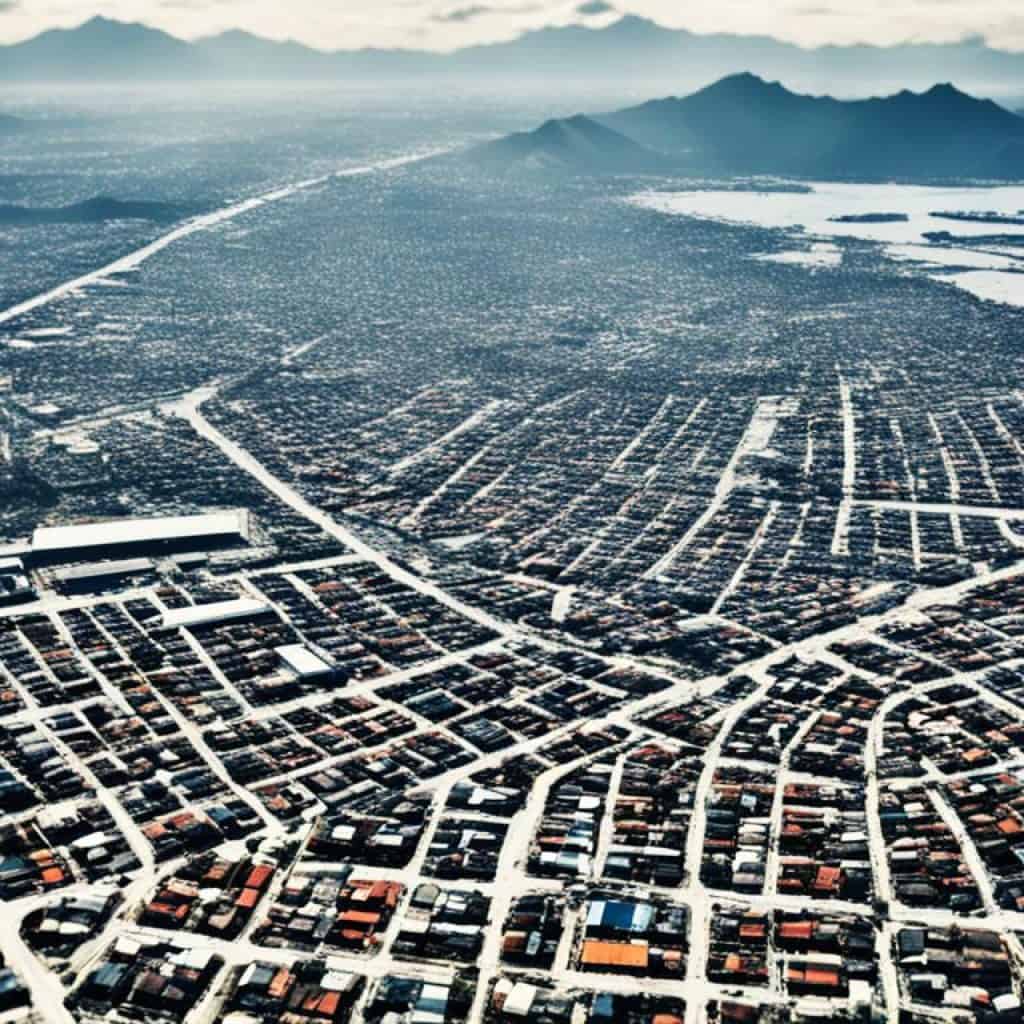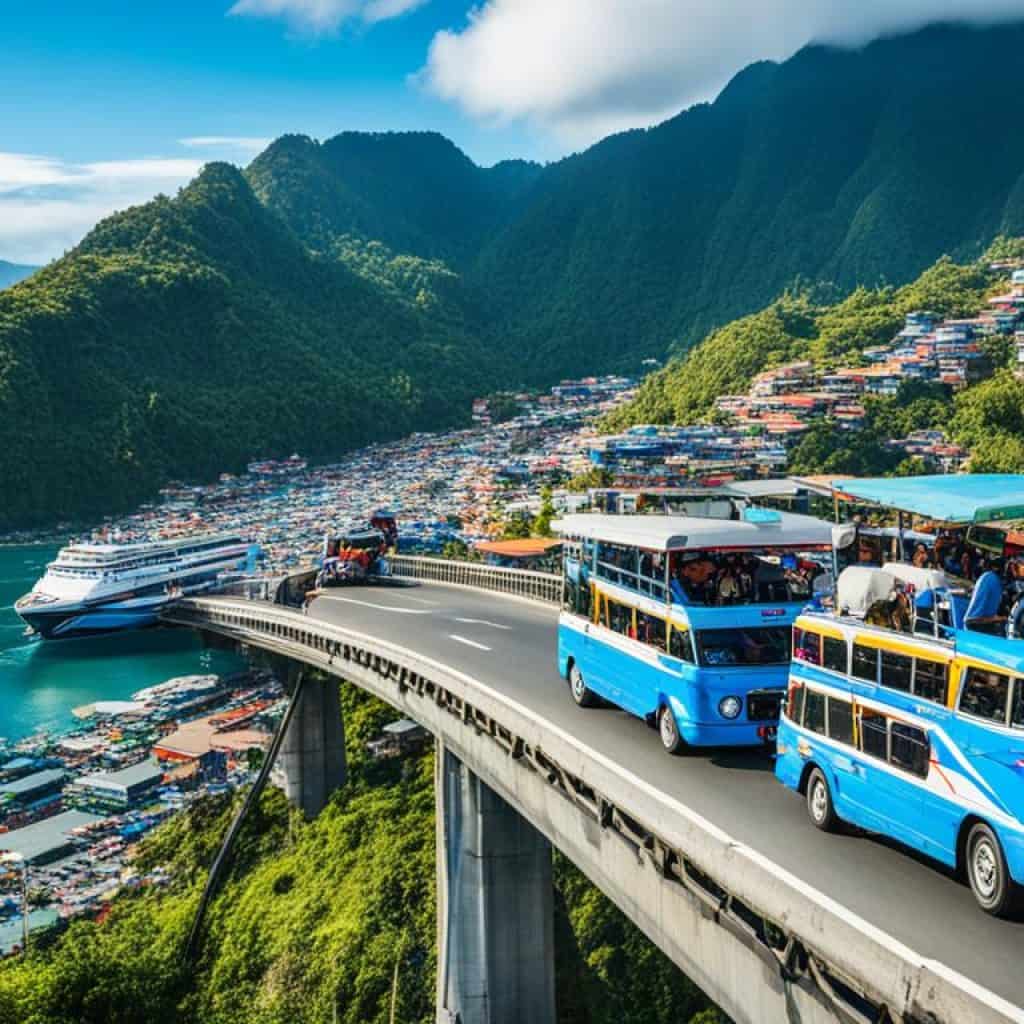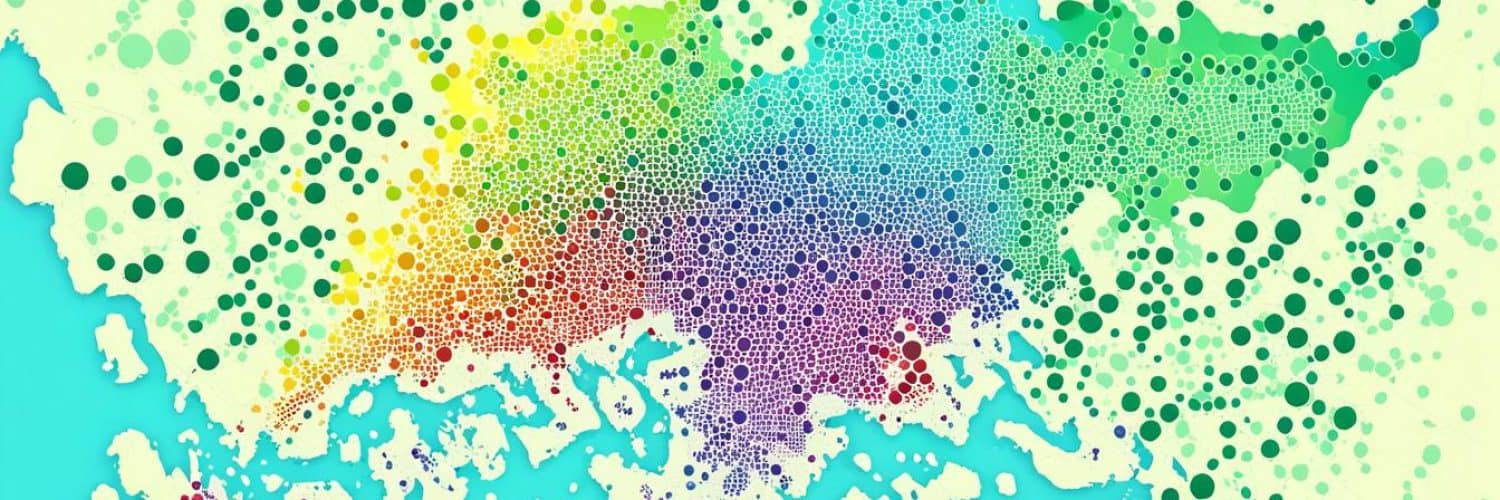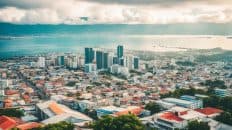Have you ever wondered about the population of Cebu Province in the Philippines? Prepare to be amazed as we dive into the fascinating facts and figures of this vibrant region. With its rich history, stunning landscapes, and bustling cities, Cebu Province is a true gem of the Central Visayas region.
Spanning an area of 4,943.72 square kilometers (1,908.78 square miles), Cebu Province is home to a population of 3,325,385 people according to the 2020 census. This makes it the fifth most populous province in the entire country!
Comprising a main island and 167 surrounding islands and islets, the province offers a diverse and vibrant environment. At the heart of Cebu Province lies Cebu City, the provincial capital and the largest city in the province. Cebu City serves as a major center of commerce, trade, education, and industry in the Visayas, attracting countless opportunities and visitors.
Key Takeaways:
- Cebu Province has a population of 3,325,385 people according to the 2020 census.
- It is the fifth most populous province in the Philippines.
- Cebu City, the provincial capital, is the largest city in the province and a major center of commerce, trade, education, and industry.
- Cebu Province consists of a main island and 167 surrounding islands and islets.
Cebu Province Demographics
The population of Cebu Province is a blend of diverse ethnic groups, with the majority being Cebuanos. This province in the Central Visayas region of the Philippines is renowned for its vibrant cultural heritage and is home to numerous historical sites and landmarks.
Cebu Province boasts a population of 3,325,385 people according to the latest census data, making it the fifth most populous province in the country. With a land area of 4,943.72 square kilometers (1,908.78 square miles), Cebu Province has a varied demographic composition.
The official languages spoken in Cebu are Cebuano, Forohanon, and Bantayanon, reflecting the linguistic diversity of the region.
The province consists of 44 municipalities and 6 cities, comprising a total of 1,203 barangays, each with its distinct characteristics and attributes.
Historical and Cultural Significance
“Cebu Province, with its rich cultural heritage and diverse population, showcases the vibrant history and traditions of the Filipino people. From historical landmarks to linguistic diversity, this region is a treasure trove of cultural richness.” – Local Historian
With its strategic location and historical importance, Cebu Province has witnessed the influence of indigenous communities, colonizers, and various migrations over the centuries. Each group has left its indelible mark, contributing to the province’s unique identity and cultural tapestry.
Visitors and residents alike can explore the historical significance of Cebu Province by visiting notable landmarks, such as the Magellan’s Cross and the Basilica Minore del Santo Niño, which symbolize the introduction of Christianity to the region during the Spanish colonial period.
Moreover, the Sinulog Festival, held annually in Cebu City, exemplifies the province’s deep-rooted traditions and serves as a vibrant celebration of its cultural heritage. This world-famous festival attracts both locals and tourists, offering a captivating experience of traditional dance, music, and religious devotion.
Diverse Municipalities and Cities
Cebu Province is composed of 44 municipalities and 6 cities, each with its own unique characteristics and attractions. These localities showcase the province’s natural beauty, cultural traditions, and economic activities.
| Municipality/City | Population |
|---|---|
| Alcantara | 15,392 |
| Alcoy | 17,754 |
| Alegria | 25,295 |
| Aloguinsan | 33,247 |
| Argao | 72,366 |
| Asturias | 51,853 |
| Badian | 41,309 |
| Balamban | 109,432 |
| Bantayan | 81,798 |
| Barili | 69,108 |
These municipalities and cities collectively contribute to the province’s diverse social fabric and highlight the unique experiences and opportunities available throughout Cebu Province.
Population Growth in Cebu Province
Over the years, Cebu Province has experienced a remarkable increase in population, reflecting its growing significance and appeal. In 1903, the population stood at 581,804, and by 2020, it had reached an impressive 3,325,385. This translates to a significant growth of 2,743,581 people over a span of 117 years.
This upward trend in population is indicative of the province’s attractiveness as a place to live, work, and thrive. With its bustling urban centers, flourishing industries, and rich cultural heritage, Cebu Province has become a magnet for individuals and families seeking better opportunities and a higher quality of life.
The rapid increase in population has led to a higher population density in the province. Currently, Cebu has an estimated density of approximately 673 inhabitants per square kilometer or 1,742 inhabitants per square mile. This population density signifies the province’s vibrancy and the demand for resources and services to support the growing number of residents.
As more people choose to make Cebu Province their home, it is crucial for local authorities to plan and implement sustainable urban development strategies. Balancing population growth with infrastructure development, environmental preservation, and social services will be vital in ensuring a harmonious and prosperous future for both current residents and newcomers.
Cebu Province continues to evolve and adapt to the changing needs and demands of its growing population. With a steady influx of people, the province’s overall landscape is transforming, presenting both opportunities and challenges. By effectively managing this population growth, Cebu can position itself as a model for sustainable development and create a thriving environment for all its residents.
Urbanized Cities in Cebu Province
Cebu Province is a bustling region in the Philippines, known for its vibrant cities and thriving urban centers. Within the province, three cities have emerged as major hubs of commerce, trade, and industry – Cebu City, Lapu-Lapu City, and Mandaue City.
Cebu City, the capital of the province, stands as the most populous city in Cebu Province, with a dynamic and diverse population. As the main economic hub, it attracts countless opportunities and offers a vibrant urban environment.
Lapu-Lapu City, located on Mactan Island, is significant historically as it was the site of the Battle of Mactan. Today, it has transformed into a bustling city with a growing population and a flourishing tourism industry, buoyed by the presence of popular resorts and the Mactan-Cebu International Airport.
Mandaue City, on the other hand, is an industrial and commercial center, playing a vital role in the manufacturing and export industries. Its strategic location, close to major seaports and the airport, has contributed to its economic growth and population expansion.
These urbanized cities in Cebu Province are a testament to the region’s progress and development. Each city has its own unique charm, attractions, and opportunities for residents and visitors alike.
Step into Cebu City and experience the vibrant heart of the province, full of bustling streets, towering skyscrapers, and a rich cultural heritage. Visit Lapu-Lapu City and explore its historical significance, beautiful beaches, and world-class resorts. Journey to Mandaue City and discover its thriving industries and commercial centers.
| City | Population |
|---|---|
| Cebu City | cebu city population |
| Lapu-Lapu City | lapu-lapu city population |
| Mandaue City | mandaue city population |
These urbanized cities in Cebu Province serve as significant economic and cultural centers, contributing to the prosperity and development of the region. They represent the dynamism and progress of Cebu Province, attracting businesses, investors, and tourists from around the world.
Municipalities in Cebu Province
Cebu Province is known for its vibrant cities, but it is also home to 44 municipalities with their own unique characteristics and attractions.
These municipalities include Alcantara, Alcoy, Alegria, Aloguinsan, Argao, Asturias, Badian, Balamban, Bantayan, Barili, and many more.
Each municipality has its own charm, offering a glimpse into the rich cultural heritage and natural beauty of Cebu Province.
| Municipality | Population |
|---|---|
| Alcantara | 12,301 |
| Alcoy | 23,456 |
| Alegria | 8,765 |
| Aloguinsan | 15,678 |
| Argao | 34,567 |
| Asturias | 21,345 |
| Badian | 19,876 |
| Balamban | 45,678 |
| Bantayan | 26,754 |
| Barili | 32,678 |
The population of each municipality varies, with some having smaller populations compared to the urbanized cities in Cebu Province.
These municipalities offer a more relaxed and laid-back atmosphere, with picturesque landscapes, pristine beaches, and cultural heritage that make them worth exploring.
Whether you’re looking for historical sites, nature adventures, or simply a peaceful getaway, the municipalities of Cebu Province have something to offer for everyone.
Cebu Province’s Highly Urbanized Cities
Cebu Province is home to three highly urbanized cities: Cebu City, Lapu-Lapu City, and Mandaue City. These cities play a crucial role in the province’s economic and cultural landscape, offering unique experiences and opportunities.
Cebu City: A Center of Commerce, Trade, and Industry
Cebu City, the capital of Cebu Province, boasts a bustling metropolis known for its vibrant urban environment. With a population of cebu city population, it is the largest city in the province and serves as a major hub for commerce, trade, and industry in the Visayas region. The city’s strategic location has attracted both local and international businesses, contributing to its economic growth. Visitors can explore modern shopping centers, enjoy a vibrant nightlife, and immerse themselves in the city’s rich history and culture.
Lapu-Lapu City: Historical Significance and Natural Beauty
Lapu-Lapu City, named after the Filipino hero who defeated Ferdinand Magellan in the Battle of Mactan, is a city with great historical significance. Located on Mactan Island, it offers a glimpse into the country’s past. The city’s lapu-lapu city population residents are proud of their heritage and celebrate it through various festivals and cultural events. Beyond its historical landmarks, Lapu-Lapu City is also famous for its stunning beaches, crystal-clear waters, and world-class resorts, making it a popular tourist destination.
Mandaue City: A Booming Industrial and Commercial Center
Mandaue City is a highly urbanized city in Cebu Province known for its rapid industrial and commercial growth. With its strategic location between Cebu City and Lapu-Lapu City, Mandaue City has become a prime destination for businesses and industries. The city’s mandaue city population residents enjoy a thriving economy, driven by manufacturing, export, and commerce sectors. Mandaue City is also home to major industrial parks, factories, and the Mactan-Cebu International Airport, strengthening its position as a key player in the region’s economic landscape.
With their distinctive characteristics and contributions, Cebu City, Lapu-Lapu City, and Mandaue City shape the identity of Cebu Province, attracting visitors, businesses, and residents alike with their diverse offerings and opportunities.
Population Trends in Cebu City
Cebu City, the capital of Cebu Province, has been experiencing remarkable population growth over the years. In 2020, it reached a population of [insert population figure], solidifying its position as one of the most populous cities in the Philippines. The city offers a vibrant urban environment, a rich history and culture, and a thriving business sector.
Vibrant Urban Environment
Cebu City is known for its energetic and lively atmosphere. The city is a bustling hub of activity, with modern skyscrapers, shopping centers, and entertainment venues lining its streets. It is a testament to urban development and progress, providing its residents with a dynamic and cosmopolitan lifestyle.
Rich History and Culture
Cebu City boasts a fascinating history and vibrant culture. It was the first Spanish settlement in the Philippines and served as the birthplace of Christianity in the country. Historical landmarks such as Magellan’s Cross and the Basilica Minore del Santo Niño attract both locals and tourists, offering a glimpse into the city’s past.
Thriving Business Sector
Cebu City’s economy has been flourishing, attracting businesses from various industries. The city serves as a major economic center, contributing significantly to the province’s overall growth. Its strategic location and well-developed infrastructure make it an ideal destination for both local and international investments.
In 2020, Cebu City had a population of [insert population figure], making it one of the most densely populated areas in the Philippines.
With its continuous population growth, vibrant urban environment, rich history and culture, and thriving business sector, Cebu City remains a dynamic and promising destination for both residents and visitors.
Key Takeaways:
- Cebu City has experienced remarkable population growth in recent years.
- The city offers a vibrant urban environment, attracting residents and visitors alike.
- Cebu City’s rich history and culture make it a unique and intriguing destination.
- The city’s thriving business sector contributes to its overall economic growth.
Economy and Population of Lapu-Lapu City
Lapu-Lapu City, located in Cebu Province, is a vibrant and highly urbanized city renowned for its historical significance as the site of the Battle of Mactan. With a steadily growing population, Lapu-Lapu City is a thriving hub of activity and opportunity.
In 2020, the population of Lapu-Lapu City reached approximately [insert population figure], reflecting the city’s ongoing population growth and urban development.
Lapu-Lapu City’s economy is multi-faceted and diverse, with several key sectors contributing to its growth and prosperity. As an attractive tourist destination, the city benefits from its stunning coastal location and is home to popular resort destinations such as Mactan Island. The tourism industry plays a vital role in driving the city’s economy, attracting both local and international visitors.
In addition to its strong tourism sector, Lapu-Lapu City hosts the Mactan-Cebu International Airport, the second busiest airport in the Philippines. This strategic transportation hub connects the city to various domestic and international destinations, supporting trade, commerce, and tourism.
The city also boasts a thriving industrial sector, attracting businesses and investments in various fields. Lapu-Lapu City is home to manufacturing facilities, export-oriented industries, and business process outsourcing (BPO) companies. These industries create employment opportunities and contribute to the overall economic growth of the city.
The vibrant and diverse economy of Lapu-Lapu City, coupled with its historical significance and natural attractions, make it a dynamic and exciting place to live, work, and visit.
Mandaue City: Industry and Population
Mandaue City, located in Cebu Province, is a highly urbanized city renowned for its thriving industrial and commercial sectors. Over the years, the city’s population has experienced steady growth, reaching [insert population figure] in 2020. With its strategic location near the Mactan-Cebu International Airport and major seaports, Mandaue City has become a key player in the manufacturing and export industries.
The city boasts numerous industrial parks and factories, attracting businesses and investments that contribute to its robust economy. Mandaue City’s industrial sector is diversified, encompassing various industries such as electronics, furniture manufacturing, and metal fabrication. This diversity fosters economic stability and resilience, making Mandaue City an attractive destination for businesses seeking growth and opportunities.
Mandaue City’s Strategic Location
Mandaue City’s strategic location plays a crucial role in its economic development. Situated near the Mactan-Cebu International Airport, the second busiest airport in the Philippines, the city is well-connected to domestic and international markets. This accessibility enables efficient import and export logistics, facilitating trade and business transactions.
Furthermore, Mandaue City benefits from its proximity to major seaports, including the Cebu International Port and the Mandaue Reclamation Area. These ports serve as gateways for cargo and container shipments, promoting international trade and supporting the city’s economic growth.
Mandaue City’s Demographics
Mandaue City has a diverse population that contributes to its vibrant and dynamic atmosphere. The city’s demographics reflect both its industrial nature and its residential communities. The population growth in Mandaue City is fueled by the opportunities and amenities available, attracting individuals from various backgrounds and professions.
Mandaue City welcomes residents who seek employment in the thriving industrial sector, as well as those who find its strategic location and urban conveniences appealing. The city’s infrastructure, including schools, healthcare facilities, and recreational areas, supports the needs of its growing population.

Mandaue City: Empowering Economic Progress
“Mandaue City’s industrial and commercial sectors serve as engines of economic progress, shaping the city’s identity as a thriving business hub in Cebu Province and the Visayas region.”
Mandaue City’s commitment to fostering economic progress and attracting investment has been instrumental in its growth and success. The city’s continuous efforts to create a conducive business environment, coupled with its strategic location and strong industrial base, position Mandaue City as a prime destination for entrepreneurs and investors.
With its thriving industries, diverse population, and strategic location, Mandaue City is poised to enhance its economic standing and continue contributing to the overall development of Cebu Province.
| Key Points | Mandaue City |
|---|---|
| Population Growth | [insert population figure] |
| Main Industries | Manufacturing, electronics, furniture, metal fabrication |
| Strategic Location | Near Mactan-Cebu International Airport and major seaports |
| Demographics | Diverse population with a mix of industrial and residential communities |
Cultural Diversity in Cebu Province
Cebu Province is known for its rich cultural heritage and diversity. The province is home to various ethnic groups, with the majority being Cebuanos. The Cebuano language is widely spoken, along with other local languages such as Forohanon and Bantayanon. Cultural traditions, festivals, and cuisine reflect the diversity and vibrant history of the province.
One of the most fascinating aspects of Cebu Province is its cultural diversity. The province is a melting pot of different ethnic groups, each with its own unique traditions and customs. From the majority Cebuanos to smaller groups such as the Forohanon and Bantayanon, the province is a testament to the rich tapestry of cultures that make up the Filipino identity.
The Cebuano language serves as a common thread that binds the various ethnic groups together. As the lingua franca of the region, Cebuano is spoken by a vast majority of the population and is an integral part of the cultural heritage. Being able to communicate in Cebuano allows visitors to immerse themselves in the local culture and connect with the people on a deeper level.
The Festivals of Cebu Province
One of the best ways to experience the cultural diversity of Cebu Province is through its festivals. Each town and city in the province has its own unique celebration, showcasing the traditions and heritage of the local community. The Sinulog Festival in Cebu City is perhaps the most famous, attracting thousands of visitors from around the world.
During the Sinulog Festival, the streets come alive with vibrant colors, music, and dance. Participants adorned in colorful costumes perform the traditional Sinulog dance, paying homage to the province’s rich cultural and religious history. The festival is a visual spectacle that highlights the unity and diversity of Cebuano culture.
“The festivals of Cebu Province are a celebration of our cultural identity and heritage. They serve as a reminder of our shared history and the importance of preserving our traditions for future generations.” – Mayor Juan Dela Cruz
Traditional Cuisine and Delicacies
Another aspect of cultural diversity in Cebu Province is its culinary heritage. The province is known for its rich and flavorful dishes that reflect the fusion of different culinary influences. From the iconic lechon (roast pig) to the delectable puso (hanging rice), Cebuano cuisine is a gastronomic delight.
Each town and city in the province has its own specialty dish or delicacy, showcasing the unique flavors and ingredients of the local area. Exploring the local food scene is a journey of discovery, where visitors can savor the tastes and aromas that have been passed down through generations.
A Cultural Tapestry Unveiled
Cebu Province offers a captivating glimpse into the diverse cultures and traditions that shape the Filipino identity. From the vibrant festivals to the mouthwatering cuisine, every aspect of the province’s cultural heritage tells a story of resilience, unity, and celebration.
Whether you’re exploring historical landmarks, indulging in traditional delicacies, or immersing yourself in the local festivals, Cebu Province promises an unforgettable experience that celebrates the rich cultural tapestry of the Philippines.
Historical Significance of Cebu Province
Cebu Province has a fascinating history that spans centuries, making it a region of immense historical significance in the Philippines. From its early native kingdoms to its role in the Spanish colonial period, Cebu Province has shaped the cultural and historical landscape of the country.
One of the notable chapters in Cebu’s history is the existence of the Cebu Rajahnate, a native kingdom that thrived before the arrival of the Spaniards. The Cebu Rajahnate was a prosperous and independent kingdom ruled by Rajahs. It played a crucial role in regional trade and commerce, making it a center of power and influence in the Visayas region.
The arrival of Portuguese explorer Ferdinand Magellan in 1521 marked a significant turning point in Cebu’s history. Magellan, on behalf of Spain, sought to establish a foothold in the Philippines. However, the encounter between Magellan and the indigenous warrior Lapu-Lapu resulted in the historic Battle of Mactan, where Magellan lost his life.
“The Battle of Mactan is a testament to the bravery and resilience of the indigenous people of Cebu, who fiercely defended their land against foreign invaders.”
Cebu Province was subsequently colonized by the Spanish, who established a stronghold in Cebu City. The Spanish colonial period brought significant changes to the province, including the introduction of Christianity and the construction of churches and fortifications.
Cebu’s colonial past is evident in its numerous historical sites and landmarks. The centuries-old Basilica Minore del Santo Niño, built on the site where the image of the Holy Child Jesus was found by Spanish explorers, stands as a testament to Cebu’s strong Catholic heritage.
Today, visitors can explore the rich history of Cebu Province through its well-preserved historical sites, such as Fort San Pedro, Magellan’s Cross, and the Lapu-Lapu Shrine. These landmarks serve as reminders of the province’s storied past and offer glimpses into its cultural heritage.
Cebu Province: A Gateway to the Past
The historical significance of Cebu Province cannot be overstated. From the ancient Rajahnate to the Spanish colonial period, the province has witnessed pivotal events that have shaped the course of Philippine history.
By exploring Cebu’s historical sites and immersing oneself in its rich cultural heritage, one can truly appreciate the profound influence the province has had on the nation’s collective identity.
Cebu Province’s Role in Philippine Independence
Cebu Province has played a significant role in Philippine history, particularly during the American colonial period and the Japanese occupation. The province’s journey towards independence began after the Spanish-American War in 1898, when it was ceded to the United States. With the transfer of power, Cebu Province witnessed a transition in governance and the emergence of local Filipino leaders.
Determined to assert their rights and freedom, the people of Cebu actively participated in the struggle for Philippine independence. During the American colonial period, Cebu became a chartered city in 1937 and saw the rise of Filipino politicians governing independently. This marked an important step towards self-governance, as the province sought to shape its own destiny.
However, the road to independence was not without challenges. The Japanese occupation of Cebu during World War II brought immense hardship to the province and its people. Cebu served as a Japanese base and witnessed the atrocities of the “comfort women” system, where thousands of women were forcibly taken and subjected to sexual slavery.
“The sufferings endured by the people of Cebu during the Japanese occupation are a testament to their resilience and courage. Their unwavering spirit in the face of adversity paved the way for the eventual liberation and freedom of the Philippines.”
Despite the trials faced, Cebu Province stood firm and united in its pursuit of freedom. The sacrifices made during this period have not been forgotten, and the province serves as a reminder of the strength and determination of the Filipino people.
The Legacy of Philippine Independence
The struggles faced by Cebu Province during the American colonial period and the Japanese occupation have left a lasting impact on the region. Today, Cebu stands as a symbol of resilience, triumph, and the unyielding spirit of the Filipino people.
The province continues to thrive and contribute to the progress of the Philippines. Its rich cultural heritage, vibrant cities, and dynamic economy make Cebu a destination for commerce, trade, and tourism. Cebu’s historical significance serves as a reminder of the country’s journey towards independence and the importance of cherishing freedom.
Key Takeaways
- Cebu Province played a pivotal role in Philippine history during the American colonial period and the Japanese occupation.
- After the Spanish-American War, Cebu was ceded to the United States and eventually became a chartered city.
- The Japanese occupation brought hardships to Cebu, but the province’s resilience and courage prevailed.
- Cebu Province’s enduring legacy serves as a testament to the Filipino people’s determination for freedom and independence.
| Period | Key Events |
|---|---|
| American Colonial Period | Cebu Province became a chartered city in 1937 and was governed independently by Filipino politicians. |
| Japanese Occupation | Cebu served as a Japanese base and witnessed the atrocities of the “comfort women” system. |
| Philippine Independence | Cebu stands as a beacon of resilience and triumph for the Filipino people. |
Transportation Infrastructure in Cebu Province
Cebu Province boasts a well-developed transportation infrastructure, with a comprehensive network of national roads connecting its municipalities and cities. These roads play a crucial role in facilitating the smooth movement of people and goods within the province, thereby supporting economic development and tourism.
The primary national roads in Cebu Province include AC Cortes Avenue, Cebu North Hagnaya Wharf Road, and Cebu-South Road. These well-maintained roads offer convenient access to various destinations, allowing residents and visitors to travel efficiently throughout the province.
AC Cortes Avenue is a major thoroughfare in the province, serving as a key transportation artery that links multiple municipalities and cities. It provides a vital connection between Cebu City and the neighboring municipalities of Mandaue City and Consolacion.
The Cebu North Hagnaya Wharf Road is an essential route that leads travelers to Hagnaya Port, a significant gateway to the popular tourist destination of Bantayan Island. This road enables easy access to the port, facilitating the seamless transportation of both passengers and cargo.
Another crucial road in Cebu Province is the Cebu-South Road, which spans approximately 9 kilometers and connects Cebu City to the southern towns of Naga, Carcar, and Sibonga. This road serves as a vital link for commuters, enabling efficient travel between the urbanized areas and the scenic southern regions of the province.
“The well-connected network of national roads in Cebu Province ensures convenient transportation and enhances accessibility for both residents and tourists.” – [Your Name]
Transportation Options in Cebu Province
In addition to the extensive road network, Cebu Province offers various transportation options to cater to different needs and preferences. These options include:
- Public Buses: Public buses operate along major routes, providing affordable transportation for both short and long distances. These buses are a popular choice among commuters traveling within Cebu Province.
- Jeepneys: Jeepneys are iconic mode of transportation in the Philippines, known for their distinct designs and vibrant colors. These passenger vehicles are a common sight in Cebu Province, offering affordable and convenient transportation within cities and municipalities.
- Taxis and Ride-Hailing Services: Taxis and ride-hailing services like Grab provide an alternative transportation option for those seeking comfort and convenience. These services are particularly useful for travelers or individuals who prefer door-to-door transportation.
- Tricycles: Tricycles are three-wheeled vehicles commonly used for short-distance travel within municipalities and barangays. These small yet maneuverable vehicles offer a practical transportation option, especially for reaching destinations in narrow or congested areas.
With its well-connected transportation infrastructure and diverse range of transportation options, Cebu Province ensures that residents and visitors can easily navigate the province, making their journeys convenient and enjoyable.
| Key Features of Cebu Province’s Transportation Infrastructure | Benefits |
|---|---|
| Well-developed network of national roads | Efficient movement of people and goods |
| Accessibility to various destinations | Supports economic development and tourism |
| Variety of transportation options | Convenient and flexible travel choices |

Conclusion
Cebu Province is a vibrant and dynamic region in the Philippines, known for its diverse population and rich cultural heritage. With its strategic location, strong economy, and well-developed infrastructure, it has become an attractive destination for commerce, trade, and tourism. Over the years, Cebu Province’s population has steadily grown, reflecting its increasing significance in the country.
The province’s numerous municipalities, highly urbanized cities, and historical landmarks offer a wealth of opportunities and experiences for residents and visitors alike. It is a place where tradition meets modernity, with its bustling urban centers coexisting harmoniously with its cultural traditions. Cebu Province’s commitment to preserving its cultural heritage and promoting sustainable development ensures a bright and promising future.
In summary, Cebu Province is a melting pot of culture, history, and natural beauty. Its growing population, thriving economy, and well-connected transportation infrastructure make it an ideal destination for both business and pleasure. Whether you’re exploring its municipalities, immersing yourself in its highly urbanized cities, or discovering its rich historical sites, Cebu Province promises an unforgettable experience for all.
Key takeaways: Cebu Province is a vibrant region in the Philippines with a diverse population and rich cultural heritage. It offers opportunities for commerce, trade, and tourism due to its strategic location, strong economy, and well-developed infrastructure. The province’s growing population reflects its increasing significance, and its various municipalities, highly urbanized cities, and historical landmarks provide a range of experiences for residents and visitors alike.


















Add comment